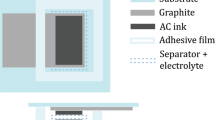Abstract
It is highly desirable to develop an electrochemical double-layer supercapacitor with high energy and power densities, improved stability and other performance parameters. This goal can only be achieved by improving the structural and electrochemical properties of the electrodes, choosing an electrolyte with improved ionic conductivity and reducing the contact resistance of the current collector and their correlated effects. Here we investigated the effect of the current collector on the electrochemical performance of a supercapacitor by choosing different current collectors with activated carbon. Furthermore, we investigated their performance by determining their physicochemical properties via x-ray diffraction, atomic force microscopy, scanning electron microscopy and FTIR spectroscopy. Additionally, electrochemical performance was ascertained using cyclic voltammetry, galvanostatic discharge measurements and impedance spectroscopy of the fabricated supercapacitors. The results show that a supercapacitor with a printed circuit board copper clad can improve the total electrochemical performance of the device. Thus, we fabricated a supercapacitor with a high specific capacitance of 166 F/g and energy density of 23 Wh/kg. The supercapacitor was found to be the choice for use in energy storage applications.
Similar content being viewed by others
References
E. Tee, I. Tallo, T. Thomberg, and E. Lust, J. Electrochem. Soc. 163, 1317–1325 (2016).
S.J. Rowley-neale and C.E. Banks, ACS Appl. Energy Mater. 1, 707–714 (2018).
T. Chen and L. Dai, Biochem. Pharmacol. 16, 272–280 (2013).
J.Y. Choi and J.H. Choi, J. Ind. Eng. Chem. 16, 401–405 (2010).
M. Jiang, et al., J. Mater. Chem. A 4, 16588–16596 (2016).
L. Liu, H. Zhao, Y. Wang, Y. Fang, J. Xie, and Y. Lei, Adv. Funct. Mater. 1705107, 1–9 (2017). https://doi.org/10.1002/adfm.201705107.
M. Natalia, Y.N. Sudhakar, and M. Selvakumar, Indian J. Chem. Technol. 20, 392–399 (2013).
Z. Wu, L. Xie, Y. Xiao, and D. Wang, J. Alloys Compd. 708, 763–768 (2017).
Y. Zhou, P. Jin, Y. Zhou, and Y. Zhu, Sci. Rep., pp. 1–7 (2018).
J. Li, et al., Electrochim. Acta 197, 84–91 (2016).
X. Peng, et al., Nat. Commun. 7, 1–8 (2016).
Acknowledgments
The authors thankfully acknowledge fruitful discussions with Pramanic (C-MET Trichur), S Sindhu (Department of Nano Science and Technology, University of Calicut). SP gratefully acknowledges the research fellowship and financial assistance from UGC-JRF. MST acknowledges the KSCSTE (SRS, SARD), UGC DAE, and UGC (MRP) for financial assistance. A portion of this research was performed using the facilities at CeNSE, IISc, Bengaluru, funded by Diety, Govt. of India and CSIF, University of Calicut.
Author information
Authors and Affiliations
Corresponding author
Additional information
Publisher's Note
Springer Nature remains neutral with regard to jurisdictional claims in published maps and institutional affiliations.
Electronic Supplementary Material
Below is the link to the electronic supplementary material.
Rights and permissions
About this article
Cite this article
Pilathottathil, S., Thayyil, M.S., Pillai, M.P. et al. Role of a Printed Circuit Board Copper Clad Current Collector in Supercapacitor Application. J. Electron. Mater. 48, 5835–5842 (2019). https://doi.org/10.1007/s11664-019-07365-6
Received:
Accepted:
Published:
Issue Date:
DOI: https://doi.org/10.1007/s11664-019-07365-6




